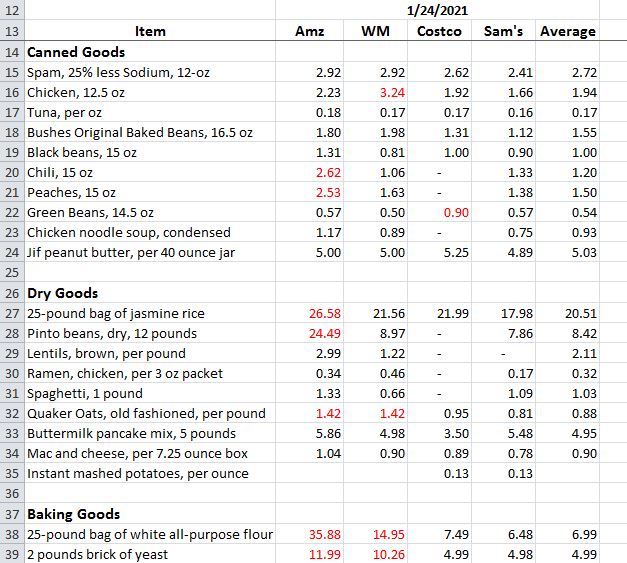To track inflation and its impact on preppers, we have developed a price-tracking spreadsheet that we will use to track the cost of a basic shopping cart of goods a prepper might buy to prepare their prepper pantry. Based on this data, we will produce a report that reflects the changes in item cost and total shopping cart cost over time. The time period will vary based on the velocity of change. For example, if prices remain steady, we won’t need to update the report very often. If prices change frequently, we will produce the report more often.
The products chosen for the basket include traditional grocery items. These are consumables an include canned goods, dry goods, baking goods, and paper products. The list is based in part on the Pickled Prepper’s 30-Day Shopping List which is designed to help you buy a 30-day supply of foods with a shelf life of at least 18 months. Separately, we will be reporting on the average cost of a gallon of gasoline, diesel, propane and heating oil as reported by the EIA, the U.S. Energy Information Administration.
Methodology
Because preppers may live in remote areas and cannot always get to a wide selection of stores (for example, our nearest Costco is some 90 minutes away by car and there is only one grocery store in the nearest town), we have done our price checking online at: Amazon.com, Walmart.com, Costco.com, and SamsClub.com. Checking the prices online has the advantage of letting us check the price of a 2-pound brick of yeast, for example, at the same time on all four sites.
Although we are reporting online purchase prices, it should be noted that you can often save money by shopping in person. When shopping online at Walmart.com, you will often see products for less that are available for store pickup only.
In the interested of fairness and to echo consumer behavior, we picked the lowest price seen on the first page of a website. To obtain the best price, we did purchase bulk packages, sometimes and two-pack and often 6, 8 or 12 cans, and divide the result accordingly to get the cost of one can. For items like tuna, that come in a 5-ounce can in some stores and a 7-ounce in others, we report the per-ounce cost.

Price Changes
Since this is our first report, we do not have data to compare the prices, so we cannot say they have one up or down. However, just doing a side-by-side comparison was interesting. Here are some notes on each outlet based on our initial observations:
Amazon.com
Amazon prides itself on having the biggest selection and the best prices, yet our analysis shows that the second half of that equation is missing, especially when it comes to large, heavy items like a 25-pound bag of rice or flour. Out of 29 grocery items on our list, Amazon’s prices on ten of them were so high that we tossed them out of our “average price” analysis because the Amazon price skewed the end result. For example, the best price we could find on Amazon for a 25-pound bag of white flour was $35.88, about five times the cost at Sam’s Club and Costco. Any of the numbers on the accompanying table in red are excluded from the average price.
In fairness, Amazon.com had the widest variety and the most gluten free foods, organic products, premium brands, and specialty selections. If you are looking for gluten-free, organic pancake mix, Amazon.com might be the pace to go. If you want a large, inexpensive container of pancake mix, you can save money shopping elsewhere.
It was also amusing to find private label foods from Costco and Sam’s club for sale on Amazon. The prices are not as good, of course, but if you really like a Kirkland product and cannot find it at Costco.com, there is always the possibility that it might be for sale on Amazon.com.
Walmart.com
In our analysis, pricing at Walmart was often competitive, but rarely were they the least expensive option.
Walmart seems to split the difference between Amazon.com and the club stores in that it has a large selection but not very many large sizes or bulk packs. In flour, for example, you could find many varieties and sizes, as long as you wanted 10 pounds or less. As a result, its price per pound or per ounce are not always as competitive as the club stores. Of course, no membership is required to shop at Walmart, and they have more walk-in locations where you can shop in person or do a curbside pickup.
If you want to walk into a store and shop for prepping supplies in person, Walmart, with 4,576 stores, is likely your best bet and more preppers will live closer to Walmart than the club stores. Costco has 546 stores, while Sam’s Club has 599. Walmart also has the advantage of offering far more goods that might be useful to a prepper, including gardening, hardware, clothing, and camping/hunting products.
Walmart offers Walmart Plus, which provides home delivery for people inside a certain delivery radius. There is an annual fee for this service, but for someone wanting to minimize possible COVID-19 exposure or simply to save time, this is an option to consider.
Costco.com
I have been a member for more than 20 years, and it has been my favorite place to stock up. Being a member also saved me $1,000 on my recent truck purchase, a savings that will pay for my membership for many years.
Looking at the spreadsheet, however, I am considering switching my allegiance to Sam’s Club simply because they have better prices and (right now, at least) a better far better in-stock situation. I don’t know if it is related to COVID-19 or not, but 11 of the 29 items on our list for were out of stock at Costco online. They may be in stock at your local store, but that doesn’t help those of us who live too far away to shop in person.
The Kirkland line of products is a plus for Costco. I have found them to be universally of good quality. It does, however, cut down on the number of familiar brands they have in stock.
Samsclub.com
If there is a “winner” of this shopping comparison, I would have to say it is Sam’s Club. They had the lowest price on more than 20 of the products we evaluated. While they were only a penny cheaper in some instances, in others there were significantly cheaper.
Thanks to our recent move, Sam’s Club is the closest club store and we will probably be going once every four to six weeks to stock up. Last time, we brought out cooler and loaded up on meats. They seem to have a huge selection of junk food and fewer non-food items than Costco, but I think we will do just fine shopping there.
There are Bargains Out There
The idea that you can get 10 pounds of pancake mix for $6.99 at Costco is impressive. This simple bag of Krusteaz just-add-water pancake mix is, in our opinion, a bargain, especially if you have kids or are feeding a large group of people. While traditionally eaten for breakfast, there’s nothing wrong with occasionally having a stack of warm, fluffy pancakes for dinner. With a little thinking outside the box, you can find other uses. For example, put a small Tupperware container of pancake mix in your bug out bag and you can cook one up in you mess kit when bugging out.
Likewise, you can get 15 pounds of grits at Sam’s Club for $6.94. While this isn’t on our comparison table, it is still bargain for preppers because it has a long shelf life and is easy to prepare. I’d say the average prepper can’t go wrong buying 20 pounds of pancake mix and 15 pounds of grits.
Canned chicken and Tuna, only 13 and 16 cents per ounce when you shop at Sam’s Club, are also hard to beat. Either one provides high-quality protein in a compact package that will last on your shelf for years. We prefer the chicken, bit will eat both.
Rice and beans is the foundation of many prepper pantries. We picked Jasmine rice for our shopping basket because it is my wife’s favorite for cooking, but for the price sensitive, a 50 pound bag of long grain rice at Sam’s Club can be had for less than the 25-pound bag of Jasmine rice.
What We Did Not Include
When preparing this list, we did not include ammunition because that market is in terrible shape. We all know ammo prices have double or even tripled. Starting to measure the cost of ammo or components now would be too late.
We also did not include freeze dried foods or other specially packaged prepping foods designed for long term storage. This was primarily because you should only need to make an investment in this specially packaged food once every 10 years or so.
Likewise, we did not include tools like an axe, a shovel, or a log splitter because most of these items are one-time purchases.
Food Inflation is Here
While we all feel the pinch of inflation in our pocketbooks, the government data doesn’t reflect a significant increase. Many believe that the government reporting of inflation data is inaccurate, and it is true that they have changed the methodology used to measure inflation since we experienced the inflationary highs of the late 1970s and early 1980s. Because many government payments, like Social Security, and tax deductions, such as the amount you can put into your IRA, are based on the Consumer Price Index (CPI), it is in the government’s best interest to keep the CPI as low as possible.
The possibility that we will face inflation on 2021 and beyond is real. It has been in the news a great deal of late. Food inflation is already with us, as we reported on January 14.
We intend to be there to monitor inflation on these key products. If we do experience food inflation, this report should help you see the changes in cost for specific products across the board.
Check back for our next update and comment below if you want to suggest any additional products for our list.








